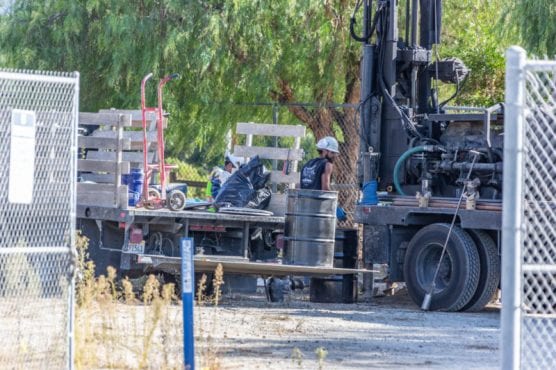Water workers responding to new state guidelines for a non-stick chemical explained to Santa Clarita Valley Water officials this week how they made necessary pipe connections recently to meet those guidelines and protect drinking water.
Mike Alvord, the agency’s director of operations and maintenance, updated agency board members Tuesday night on how the agency is dealing with a family of chemicals called polyfluoroalkyl substances, or PFAS, for short.
The bottom line in light of all the discussion about the work and the chemical: The SCV’s drinking water in the Santa Clarita Valley remains safe and clean and meets all state and federal guidelines.
In a Dec. 3 memo sent to the board, Alvord described how agency workers are working to meet an “aggressive timeline” of strict state standards limiting the presence of PFAS to minuscule amounts.
“The most potentially impacted zone from the lowering of PFAS notification/response levels will be the VWD Zone IIA-N,” Alvord told The Signal Monday, referring to the areas of Tesoro del Valle and Valencia as areas likely impacted by PFAS given changing state limits.
Notification levels are levels of a contaminant in water that require no action but do demand that public officials are notified. Response levels require action to correct the problem.
Interconnections
“In order for SCV Water to move water around our various systems and zones, these interconnections help accomplish this,” he said about the recent pipe connections.
“The Tesoro Zone IA zone will provide water to VWD’s Zone IIIA. This will help alleviate the need for VWD’s Zone IIA-N from having to pump water out and into this zone,” he said.
The connection will help provide water directly to VWD’s Zone IIA-N, he said.
“In short, these zones help move water around to alleviate any loss of groundwater wells from PFAS,” Alvord said.
And, while the agency has been moving quickly to install the pumps and equipment needed to meet state contamination levels for PFAs, General Manager Matt Stone was moved to update his ratepayers about the chemical and the battle to contain it.
“Ensuring that water that is safe to drink and reaches your home 24/7 is a top priority for the SCV Water team,” he said in a notice to ratepayers and in the agency’s newsletter, “Water Currents.”
“You may have heard recent quarterly water well testing detected perfluorooctanoic acid and perfluoroctanesulfonic acid, known as PFAS,” he said.
Non-stick cookware
PFAS are found in thousands of commonly used products, he said, like non-stick cookware, food wrappers, firefighting foam and cleaning products. And, like many communities throughout the nation, tiny amounts of PFAS have entered the SCV’s water supply.
“To monitor for PFAS and other substances, we test thousands of times per year to ensure our water meets or surpasses state and national water-quality standards,” he said. “We are committed to clear and timely communication, and this special edition of ‘Water Currents’ is full of information on PFAS and how we are taking immediate steps to tackle this substance in our drinking water through new, innovative strategies and proven treatment options.”
On Tuesday, Alvord updated board members on exactly what those innovative strategies and treatment options are.
Treatment plant
In September, the agency began work on a treatment plant next to the William S. Hart Pony Baseball & Softball park to remove the chemical from groundwater in the Santa Clara River.
Officials at the SCV Water Agency found trace amounts of PFAS 17 in its wells, requiring them to notify key agencies about the discovery.
The trace amounts were so minuscule that none of wells required being shut down under state-set guidelines.
The day will come, local water officials believe, when the state tightens those guidelines even further, threatening the closure of local wells.
Construction of the PFAS water treatment facility is scheduled to take place between February and June of next year.
In August, all operating SCV Water wells were sampled for PFAS and 27 total wells exceeded one or both of the revised notification levels for PFOS and PFOA — levels requiring them to notify public officials.
Last month, all wells were once again sampled for PFAS.
Alvord, in his memo to the board, pointed out that “several other well locations have been identified to implement PFAS treatment,” naming specifically the locations in Tesoro and Valencia.
Health concerns
Studies indicate that both PFOA and PFOS can have reproductive, developmental, liver, kidney, thyroid and immunological effects in laboratory animals. Both sets of chemicals have caused tumors in animals.
With regards to humans, studies show increased cholesterol levels, liver enzymes and uric acid among exposed populations, with more limited findings related to:
Decreased infant birth weights.
Negative effects on the immune system, including decreased response to vaccinations.
Cancer, for PFOA chemicals.
The PFAS family of chemical was widely manufactured in the U.S. between 1950 and 2015, and the chemicals are primarily used in industrial and consumer products to repel grease, moisture, oil, water and stains.
Like this:
Like Loading...
Related





 Tweet This
Tweet This Facebook
Facebook Digg This
Digg This Bookmark
Bookmark Stumble
Stumble RSS
RSS


























REAL NAMES ONLY: All posters must use their real individual or business name. This applies equally to Twitter account holders who use a nickname.
0 Comments
You can be the first one to leave a comment.